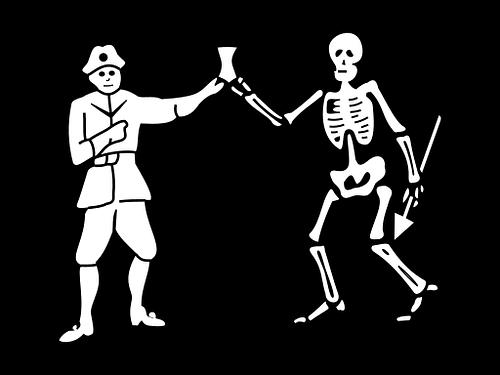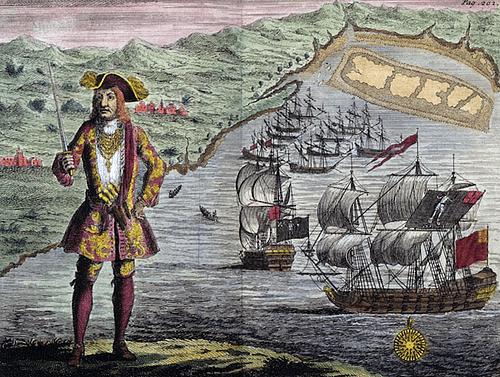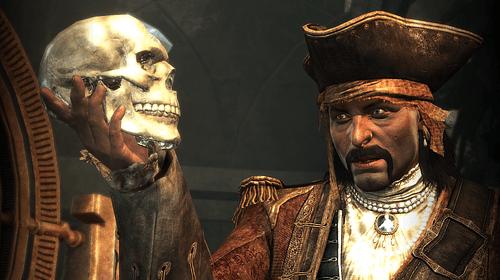Bartholomew Roberts, aka 'Black Bart' Roberts (c. 1682-1722), was a Welsh pirate and one of the most successful villains of the Golden Age of Piracy. Roberts plundered over 400 ships on both sides of the Atlantic during his infamous three-year career, far more than any other pirate of the period.
Known for his flashy wardrobe, provocative Jolly Roger flags, and being a stickler for discipline, 'Black Bart' Roberts commanded one of the most powerful of all pirate ships, the Royal Fortune which had at least 40 cannons. Keen to avoid the hangman’s noose so many other pirates had felt tickle their necks, Roberts was shot in the throat resisting capture by the English authorities in 1722.
Early Career
Roberts was born in Pembroke County, Wales, in 1682, his real first name being John. John Roberts went to sea around age 13, and he grew into a tall, deeply-tanned, and weather-worn chap that resulted in his later nickname 'Black Bart' Roberts (or 'Black Barty'). An alternative source of this moniker was that Roberts often tortured his captives - especially French ones - to find out exactly where they kept their valuables. In one notorious episode in October 1720, Roberts ordered his men to cut the ears off a group of Dutch captives, some were hanged and their bodies used for target practice. So, then, either way, 'Black Bart' Roberts certainly lived up to his name.
As a young man, Roberts served as second mate on the Princess of London, a slave ship that plied the route between the coast of West Africa and London. Then, in February 1720, he joined, either by force or voluntarily, the crew of the Welsh pirate Howell Davis who had captured the Princess. It was at this stage that Roberts changed his Christian name to Bartholomew to make it more difficult for the authorities to discover his identity. When Davis died in an engagement with the Portuguese authorities on the Island of Princes (Principe Island) off the West African coast, Roberts was elected by the crew to take over. Captain Roberts swiftly launched a revenge attack on the fort of the Island of Princes and razed it to the ground along with the nearby town.

Scourge of the Atlantic
Roberts criss-crossed the Atlantic Ocean, plundering ships off the coast of West Africa, in the Caribbean, off the coast of Brazil, and along the east coast of North America as far north as Newfoundland where he caused havoc amongst the fishing fleets. Far from limiting himself to single ships, Roberts often captured entire fleets such as the 11 vessels he took off the West African coast in January 1722. The captains of these slave ships were asked for a quantity of gold to get their ships back again, gold which had been intended for use in purchasing slaves. One captain refused and so Roberts covered his ship in tar and burnt it into a wreck. 80 slaves still in the ship’s hold were disregarded by the pirate captain. Roberts used local intelligence, capturing mariners to gain information about particular fleets, and he used various ruses such as flying a nation’s flag to approach a target. Roberts was not always interested in mere plunder. In the Leeward Islands in 1720, he set fire to a whole host of ships in harbour as revenge for a recent hanging of brethren pirates on St. Kitts.
Roberts gave his own justification for his dastardly life of crime:
In an honest service, there is thin commons, low wages, and hard labour. In this, plenty and satiety, pleasure and ease, liberty and power; and who should not balance creditor on this side, when all the hazard that is run for it, at worst, is only a sour look or two at choking. No, a merry life and a short one shall be my motto.
(frontispiece, Cordingly & Falconer)
Roberts was a charismatic leader of men and, most important of all, hugely successful in acquiring plunder to share with them. He did, though, suffer one mutiny in 1720 when a lieutenant, one Walter Kennedy (hanged 1721), made off with two ships he had captured. Curiously, Roberts never touched alcohol, his favourite tipple being nothing stronger than tea.

Roberts’ Jolly Roger Flags
Captain Roberts was partial to dressing up for his role as history’s pirate extraordinaire, and he gained fame for wearing bright red silks in battle. According to the celebrated pirate’s who’s who A General History of the Robberies and Murders of the Most Notorious Pyrates, compiled in the 1720s by Charles Johnson/Daniel Defoe, Roberts went into battle with style:
Roberts being dressed in a rich crimson damask waistcoat and breeches, a red feather in his hat, a gold chain round his neck, with a diamond cross hanging to it. a sword in his hand, and two pairs of pistols hanging at the end of a silk sling flung over his shoulders, according to the fashion of pirates.
(243)
Such was Roberts’ love of scarlet wardrobe accessories, the French nicknamed him le jolie rouge. Roberts was known to fly the skull and crossbones flag, amongst others on his fleet of ships and so this flag may have become more generally known as the 'Jolly Roger' for its association with Roberts (although there are plenty of other theories as to the origin of the 'Jolly Roger' name).
Black Bart Roberts’ most famous Jolly Roger flag showed him drinking a cup of wine with a skeleton or devil grasping a burning spear. Pirates were not above a bit of self-promotion, and Roberts’ personal banner showed him with a sword and standing on top of two skulls. Under the skulls were the letters ABH and AMH, signifying that they represented the decapitated heads of the governors of Barbados and Martinique respectively ("A Barbadian Head" and "A Martiniquan Head"), both of whom sent ships in pursuit of Roberts.
The Royal Fortune
Unlike most pirates, who preferred a lightly-armed, small but fast vessel with a shallow draught like a sloop, Roberts commanded a large ship bristling with 42 cannons (or 52 in some sources), the Royal Fortune. Roberts had worked his way up, capturing ever bigger and better-armed vessels over his years of piracy, reusing the name Royal Fortune several times. This, the most famous Royal Fortune, was a French warship built around 1697 in Bayonne. Roberts captured it in Caribbean waters near Martinique thanks to the pirate having a fleet of several ships at his disposal. As an added bonus, on board at the time and so taken captive was no less a person than the governor of Martinique. Roberts detested all authority and the persistent attempts to bring him to justice and so it was with great relish that he hanged the governor from the yardarm, at least according to the account given by Johnson/Defoe in A General History.
The square-rigged and well-armed Royal Fortune allowed Roberts to exchange broadsides with any naval ship sent against him. A Danish victim of an attack by Roberts gave the following description of the Royal Fortune and its armaments:
The said Roberts’ ship is manned with about 180 white men and about 40 French Creole negroes and has mounted 12 eight-pounders; 4 twelve-pounders; 12 six-pounders; 6 [bronze] eight-pounders; and 8 four-pounders; and in [beneath] her main and foremast has 7 guns, two and three pounders, and 2 swivel guns upon her mizzen.
(Konstam, The Pirate Ship, 24)
Roberts soon had to abandon his French Royal Fortune, most likely because the hull was beyond repair after a decade of tropical marine creatures eating away at it. From early 1721, he sailed the Onslow, a ship of the Royal Africa Company. It was renamed Royal Fortune (the fourth and last of Roberts’ ships with this name) and, by removing internal bulkheads not needed to separate cargo anymore, space was created for 40 cannons. The superstructures fore and aft were also removed to make the ship lighter, faster, and more manoeuvrable. The extra deck space also allowed more guns to be carried.
Black Bart Roberts’ Pirate Articles
It was not uncommon for pirate captains to draw up a list of rules for their crew known as the ship’s articles. Each man was obliged to sign (leaving his mark if he could not write) such a document and swear his obedience to them. The articles of Roberts were compiled by Johnson/Defoe from the testimony of former crew members and presented in his pirate’s who’s who. The articles by which the crew had to abide contain some directives one might expect to find such as:
To keep their piece [musket etc.], pistols, and cutlass clean, and fit for service.
No boy or woman to be allowed. If any man is found seducing any of the latter sex, and carries her to sea, disguised, he is to suffer death.
To desert the ship, or their quarters in battle, is punished with death or marooning [abandonment on a desert island or small boat without provisions].
There are points illustrating the relative fairness and equality between crew members:
Every man has a vote in affairs of moment, has equal title to the fresh provisions or strong liquors, at any time seized, and may use them at pleasure, unless a scarcity make it necessary, for the good of all, to vote a retrenchment.
Then there are some more surprising points for a bunch of cutthroats to consider such as:
No person to game at cards or dice for money.
The musicians to have rest on the sabbath day. (211-212)

Death
The notorious pirate, as he himself had predicted, was to enjoy only a very short career in crime. In February 1722, Roberts and his crew were on board the Royal Fortune anchored off Cape Lopez, Gabon having spent the previous night partying to celebrate their latest round of captures. Roberts was killed on 10 February on board his ship after a prolonged engagement with the Royal Navy frigate HMS Swallow commanded by Captain Challoner Ogle (1681-1750) who had been searching for Roberts for several months. A tropical storm began to blow and the two ships had struggled to manoeuvre into a position of advantage over the other. As the two vessels passed close to each other, Roberts was fatally hit in the throat by metal fired as grapeshot from one of Swallow’s cannons. The body of the fallen captain was put overboard by his men, as he had often instructed them to do in such an eventuality in order that the authorities did not take it and hang it in public.
Ogle’s men won the day after a three-hour battle, and 268 pirates were captured. Roberts’ crews had often included former slaves, either released from captured slave ships or escapees from colonial plantations who had volunteered for a life of piracy. 77 black African slaves who had fought as pirates were captured by Captain Challoner, and they were all returned to slavery. Tried and found guilty of piracy and murder, 52 of Roberts’ pirate crew were hanged in sight of the walls of Cape Coast Castle, Guinea. This was the largest public execution of pirates in the so-called Golden Age of Piracy. Another 20 men were sentenced to hard labour in West Africa, another form of death sentence since very few survived very long in such penal colonies. Captain Ogle, meanwhile, received a knighthood for his efforts and ended his career with the rank of admiral.
